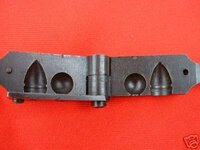Digger7
Tenderfoot
- Oct 22, 2013
- 6
- 0
- Primary Interest:
- All Treasure Hunting
I guess this question is directed to Cannon Ball Guy (a friend told me you would probably know)... or anyone else who may know the answer.
We have found about 100 Colt. 44 drops at the Civil War campsite we are working. Thomas & Thomas have the bullet listed as the Colt Army "New Model", bullet number 32 on page 16. McKee & Mason have an "early model" listed as bullet number 82 on page 27 but it lacks the lower recess.
My question is this: both books have the Colt .44 listed as a pistol bullet, but I have a reproduction 1860 Colt Army pistol and a reproduction Remington 1858 Army pistol and neither of these guns have enough clearance for the bullet to be placed in the cylinder and rotated under the plunger to press the bullet into the cylinder. How were these bullets loaded into the original model guns.
The accompanying picture is the bullet in question. It is .675 long, .455 in diameter, and 196 grains in weight. Any help would be appreciated.

We have found about 100 Colt. 44 drops at the Civil War campsite we are working. Thomas & Thomas have the bullet listed as the Colt Army "New Model", bullet number 32 on page 16. McKee & Mason have an "early model" listed as bullet number 82 on page 27 but it lacks the lower recess.
My question is this: both books have the Colt .44 listed as a pistol bullet, but I have a reproduction 1860 Colt Army pistol and a reproduction Remington 1858 Army pistol and neither of these guns have enough clearance for the bullet to be placed in the cylinder and rotated under the plunger to press the bullet into the cylinder. How were these bullets loaded into the original model guns.
The accompanying picture is the bullet in question. It is .675 long, .455 in diameter, and 196 grains in weight. Any help would be appreciated.








